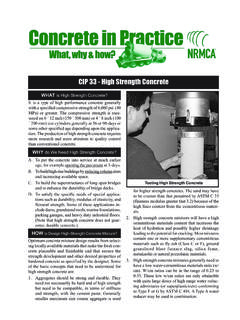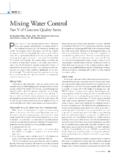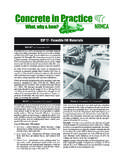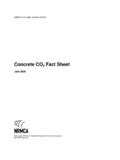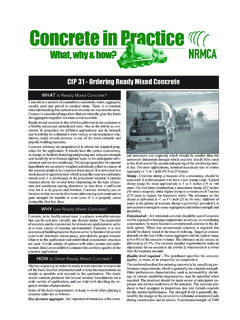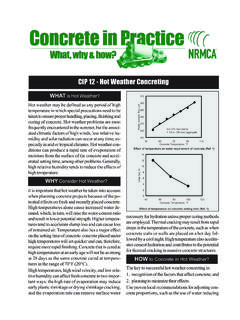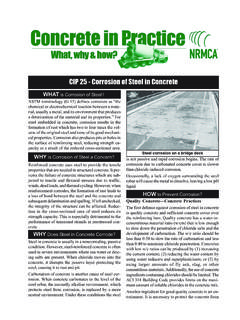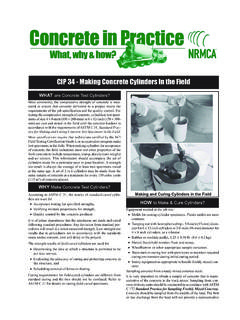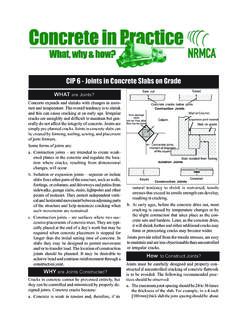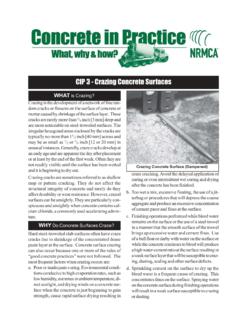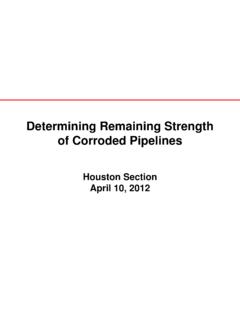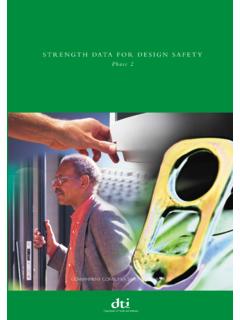Transcription of CIP 35 - Testing Compressive Strength of Concrete
1 CIP 35 - Testing Compressive Strength of ConcreteWHATis the Compressive Strength of Concrete ?WHYis Compressive Strength Determined? Concrete mixtures can be designed to provide a wide rangeof mechanical and durability properties to meet the designrequirements of a structure. The Compressive Strength ofconcrete is the most common performance measure used bythe engineer in designing buildings and other Compressive Strength is measured by breaking cylin-drical Concrete specimens in a compression- Testing Compressive Strength is calculated from the failure loaddivided by the cross-sectional area resisting the load andreported in units of pound-force per square inch (psi) in USCustomary units or megapascals (MPa) in SI units. Con-crete Compressive Strength requirements can vary from 2500psi (17 MPa) for residential Concrete to 4000 psi (28 MPa)and higher in commercial structures.
2 Higher strengths up toand exceeding 10,000 psi (70 MPa) are specified for Strength test results are primarily used todetermine that the Concrete mixture as delivered meets therequirements of the specified Strength , c, in the test results from cast cylinders may be used forquality control, acceptance of Concrete , or for estimatingthe Concrete Strength in a structure for the purpose ofscheduling construction operations such as form removalor for evaluating the adequacy of curing and protectionafforded to the structure. Cylinders tested for acceptanceand quality control are made and cured in accordance withprocedures described for standard-cured specimens inASTM C 31 Standard Practice for Making and CuringConcrete Test Specimens in the Field.
3 For estimating the in-place Concrete Strength , ASTM C 31 provides proceduresforfield-curedspecimens. Cylindrical specimens are testedin accordance with ASTM C 39, Standard Test Method forCompressive Strength of Cylindrical Concrete test result is the average of at least two standard-curedstrength specimens made from the same Concrete sampleand tested at the same age. In most cases strengthrequirements for Concrete are at an age of 28 engineers us the specified Strength cto designstructural elements. This specified Strength is incorporatedin the job contract documents. The Concrete mixture isdesigned to produce an average Strength , cr, higher thanthe specified Strength such that the risk of not complyingwith the Strength specification is minimized. To comply withthe Strength requirements of a job specification both thefollowing acceptance criteria apply: The average of 3 consecutive tests should equal orexceed the specified Strength , c No single Strength test should fall below cby morethan 500 psi ( MPa); or by more than c when c is more than 5000 psi (35 MPa)It is important to understand that an individual test fallingbelow c does not necessarily constitute a failure to meetspecification requirements.
4 When the average of strengthtests on a job are at the required average Strength , cr, theprobability that individual Strength tests will be less thanthe specified Strength is about 10% and this is accountedfor in the acceptance Strength test results indicate that the concretedelivered fails to meet the requirements of the specification,it is important to recognize that the failure may be in thetesting, not the Concrete . This is especially true if thefabrication, handling, curing and Testing of the cylinders arenot conducted in accordance with standard procedures. SeeCIP 9, Low Concrete Cylinder Strength test records are used by the concreteproducer to establish the target average Strength of concretemixtures for future Test Specimen at Failure2003 HOWto Test the Strength of Concrete ?
5 Cylindrical specimens for acceptance Testing should be 6x 12 inch (150 x 300 mm) size or 4 x 8 inch (100 x 200 mm)when specified. The smaller specimens tend to be easierto make and handle in the field and the laboratory. Thediameter of the cylinder used should be at least 3 timesthe nominal maximum size of the coarse aggregate usedin the Concrete . Recording the mass of the specimen before cappingprovides useful information in case of disputes. To provide for a uniform load distribution when Testing ,cylinders are capped generally with sulfur mortar (ASTMC 617) or neoprene pad caps (ASTM C 1231). Sulfur capsshould be applied at least two hours and preferably oneday before Testing . Neoprene pad caps can be used tomeasure Concrete strengths between 1500 and 7000 psi(10 to 50 MPa).
6 For higher strengths upto 12,000 psi,neoprene pad caps are permitted to be used if they arequalified by companion Testing with sulfur hardness requirements for neoprene pads varyfrom 50 to 70 depending on the Strength level should be replaced if there is excessive wear. Cylinders should not be allowed to dry out prior totesting. The cylinder diameter should be measured in twolocations at right angles to each other at mid-height ofthe specimen and averaged to calculate the cross-sectional area. If the two measured diameters differ bymore than 2%, the cylinder should not be tested. The ends of the specimens should not depart fromperpendicularity with the cylinder axis by more than and the ends should be plane to within inches ( ). Cylinders should be centered in the compression-testingmachine and loaded to complete failure.
7 The loading rateon a hydraulic machine should be maintained in a rangeof 20 to 50 psi/s ( to MPa/s) during the latter halfof the loading phase. The type of break should berecorded. A common break pattern is a conical fracture(see figure). The Concrete Strength is calculated by dividing themaximum load at failure by the average cross-sectionalarea. C 39 has correction factors if the length-to-diameterratio of the cylinder is between and , which israre. At least two cylinders are tested at the same age andthe average Strength is reported as the test result to thenearest 10 psi ( MPa) The technician carrying out the test should record thedate they were received at the lab, the test date, specimenidentification, cylinder diameter, test age, maximum loadapplied, Compressive Strength , type of fracture, and anydefects in the cylinders or caps.
8 If measured, the mass ofthe cylinders should also be noted. Most deviations from standard procedures for making,curing and Testing Concrete test specimens will result in alower measured Strength . The range between companion cylinders from the sameset and tested at the same age should be, on average,about 2 to 3% of the average Strength . If the differencebetween two companion cylinders exceeds 8% too often,or for three companion cylinders, the testingprocedures at the laboratory should be evaluated andrectified. Results of tests made by different labs on the sameconcrete sample should not differ by more than about13% of the average of the two test results. If one or both of a set of cylinders break at Strength below c, evaluate the cylinders for obvious problems and holdthe tested cylinders for later examination.
9 Frequently thecause of a failed test can be readily seen in the cylinder,either immediately or by petrographic examination. If it isthrown away an easy opportunity to correct the problemmay be lost. In some cases additional reserve cylindersare made and can be tested if one cylinder of a set brokeat a lower Strength . A 3 or 7-day test may help detect potential problemswith Concrete quality or Testing procedures at the lab butis not a basis for rejecting Concrete , with a requirementfor 28-day or other age Strength . ASTM C 1077 requires that laboratory techniciansinvolved in Testing Concrete must be certified. Reports of Compressive Strength tests provide valuableinformation to the project team for the current and futureprojects. The reports should be forwarded to the concreteproducer, contractor and the owner s representative asexpeditiously as ASTM C 31, C 39, C 617, C 1077, C 1231, Annual Book ofASTM Standards, Volume , ASTM, West Conshohocken,PA, in Practice Series, NRMCA, Silver Spring, MD, Strength Evaluation - A Recommended Practice,NRMCA Publication 133, NRMCA RES Committee,NRMCA, Silver Spring, producers can correct improper test-cylinder curing, WardR.
10 Malisch, Concrete Producer Magazine, November 1997, Checklist for Concrete Pre-ConstructionConference, NRMCA, Silver Spring, of Variables That Influence Measured ConcreteCompressive Strength , David N. Richardson, NRMCAP ublication 179, NRMCA, Silver Spring, on Control Tests for Quality Concrete , PA015, PortlandCement Association, Skokie, IL, 214, Recommended Practice for Evaluation of StrengthTests Results of Concrete , American Concrete Institute,Farmington Hills, MI.
